I have to admit that there have been one or two occasions in my lifetime when I’ve lost a library book.
I’ve never had a reasonable excuse (the overflowing levels of books in my home may be what has swallowed them up, but I cannot use this an acceptable defence). I’ve certainly never been able to claim that any loss was on account of a wild bear hungry for words.
 But a twelfth century Brother Hugo could and did. Or at least he does in the delightful and engaging Brother Hugo and the Bear by Katy Beebe, illustrated by S. D. Schindler .
But a twelfth century Brother Hugo could and did. Or at least he does in the delightful and engaging Brother Hugo and the Bear by Katy Beebe, illustrated by S. D. Schindler .
To make good the loss of a missing manuscript, Brother Hugo is ordered by his Abbot to prepare a fresh copy. Having borrowed the neighbouring monastery’s version of the lost text, we follow Hugo as he carefully recreates the book that has disappeared.
All goes well until his journey to return the loaned copy, when he is stalked by a hungry bear…
A historical note at the end of the book quotes from an extant letter written by Peter the Venerable (c. 1092 – 1156, a real-life abbot who published the first Latin edition of the Koran amongst other things):
“And send to us, if it pleases you, the great volume of letters by the holy father Augustine, which contains his letters to Saint Jerome, and Saint Jerome’s to him. For it happens that the greater part of our volume was eaten by a bear.“
Beebe has used this historical fact to build a captivating and funny story. We learn a lot about how books were at one time made including where parchment comes from and how some inks were made. But this is no dry non-fiction text.
Historical figures and settings come to life in ways which make them real and relevant; “The dog ate my homework” is an excuse I’ve yet to hear in real life – a bit like seeing someone slip on an actual banana skin – but it’s an excuse we are all familiar with, and which resonates clearly with poor Hugo and his encounter with the bear. Beebe’s text is perfectly peppered with slightly archaic language, giving a lovely flavour seasoned just right for using this book with slightly older children.

Schindler’s illustration are a delight, drawing heavily on many styles and motifs used in mediaeval manuscripts. Illuminated letters start each paragraph and the finely executed, detailed ink and water colour illustrations contain much humour. As befits a book about hand-created manuscripts, Schindler’s illustrations are completely executed by hand (you can learn more on Schindler’s blog), without computer manipulation, a relatively rare thing these days in picture books.
Text and illustration are both splendid but what truly completes this book is the inclusion not only of a historical note and glossary but also a commentary from both author and illustrator on the inspiration and process of their work. This adds real depth to an already interesting and beautiful book.
Brother Hugo and the Bear has appeared on several “best of 2014″ book lists in the US, including 2014 American Booksellers Association Best Books for Children Catalog, Kirkus Best of 2014 and School Library Journal Best Books of 2014 and it is certainly worth ordering a copy of this American import (unfortunately you’re unlikely to find this in a UK library). It would make an ideal book to use as the basis of some activities for World Book Day.
Inspired by Brother Hugo we wanted to make our own illuminated manuscripts. Using some colouring-in pages printed from the web as our inspiration we drew outlines for illuminated letters using pencils before going over them with ink.


The inked letters were then filled in with watercolour and a little bit of gold guache before being leather bound.

Completely at their own instigation the girls used a Latin dictionary to find words they liked to write in their manuscripts.

Whilst making our manuscripts we listened to various 12th century music such as this, this and this.
Other activities which would work well alongside reading Brother Hugo and the Bear include:
Watching this hilarious video about the changes from scrolls to codices in the history of the book:
Making your own ink. There are lots of different recipes from this using egg yolk, lamp black and honey to this one recycling old felt tips which seem to have run out.
Browsing online images from illuminated manuscripts. Both the British Library and the National Library of the Netherlands have fabulous, searchable illuminated manuscript databases
Watching the super, award winning, family-friendly feature length animation The Secret of Kells, which as you might guess from its title is about creating an illuminated manuscript.
This year sees the 10th anniversary of another of my favourite books about books: Charlie Cook’s Favourite Book written by Julia Donaldson and illustrated by Axel Scheffler. Over the course of the next few weeks I’ll be reviewing a few new book-themed book discoveries – but do let me know your favourite picture books which celebrate books and the joy of reading.
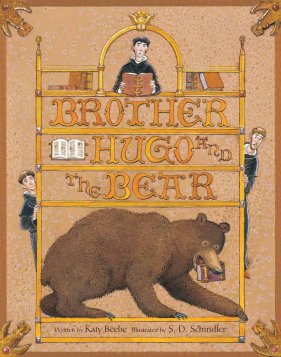 .
.
Brother Hugo and the Bear
Written by Katy Beebe
Illustrated by S. D. Schindler
Eerdmans’s Books for Young Readers 4/01/2014
978-0-8028-5407-0
Age 5 to 9 34 pages
.
“It befell that on the first day of Lent, Brother Hugo could not return his library book. The Abbot was most displeased. ‘Our house now lacks the comforting letters of St. Augustine, Brother Hugo. How did this happen?’ The precious book, it turns out, has been devoured by a bear, and so Hugo must replace it. Letter by letter and line by line the hapless monk crafts a new book, all the while being trailed by a hungry new friend who thinks that the words of St. Augustine are truly far sweeter than honey. Based loosely on a note found in a twelfth-century manuscript—and largely on the creative imaginings of the author—this humorous tale will surely delight readers who have acquired their own taste for books.”
Opening
“It befell that on the first day of Lent, Brother Hugo could not return his library book. ‘I shall have to inform the Abbot of this, Brother Hugo,’ said the librarian.”
Review
Poor Brother Hugo. A bear has eaten his library book, an important book for the monastery. To replace the book, Brother Hugo must first travel to a neighboring monastery and borrow their copy of St. Augustine. Throughout Lent, Brother Hugo must then copy this book, by hand, for his own monastery. Brother Hugo and the Bear is a beautiful book. The text looks similar to what one would find in an old religious tome, as do the illustrations. Each paragraph begins with a large letter entwined with grape vines and leaves. As for the bear, with those long claws it is no wonder Brother Hugo did nothing when the bear snatched St. Augustine from his hands.
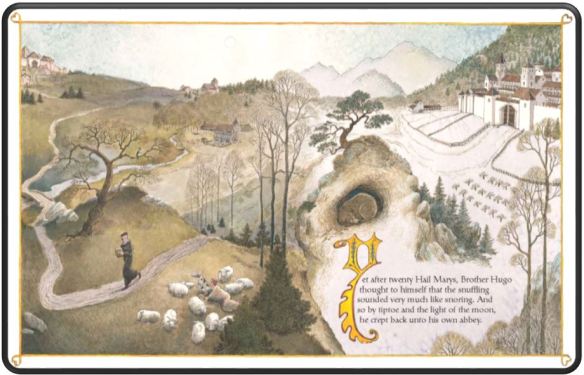
I like that all the monks help Brother Hugo prepare the things he needs to make the new book. It was not as easy as going to the stationary store, as it would be today.The monks had to make everything by hand. The illustrations show an offended goose walking away from the monks who now have a bird feather from which to fashion a pen. There is so much detail in Brother Hugo and the Bear one must take a second look after reading the story. I love illustrative detail and Brother Hugo and the Bear is loaded with details. I noticed a bear hiding behind the tree as Brother Hugo leaves the other monastery. Even the two dogs look in the direction of the tree and bark. Alas, that bear never follows Brother Hugo. (Maybe he is a scout for the book-eating bear.)
While Brother Hugo toils at his writing task, outside a noise begins to disturb the entire monastery.
“Brother Hugo, Brother Hugo,” the other monks cried, “what can be the meaning of that noise? It is like the rumbling of a great stomach or the whooshing of a fierce wind.”
The monks had the answer. It is the bear, hungry for another masterpiece. Once more, Brother Hugo’s friends help ensure the safe return of the original St. Augustine to the other monastery. On his return trip, Brother Hugo takes along a sack from his friends along with the original book. The contents of that sack should keep the bear at bay while Brother Hugo travels. The author uses the word “snuffling” to describe the noise made by the bear. I looked this up and found that the bear has a cold and is trying to breathe through a blocked nose. Poor Bear. I really like this word and hope kids take the time to look up its meaning.
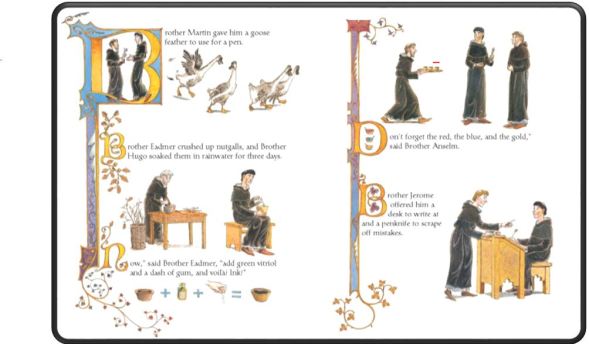
I was surprised to learn the story is based on a true event. There was actually a bear who ate a book in the middle ages. How interesting. The backmatter goes into detail as to how the author, first-time children’s author Katy Beebe, came up with the story. The illustrator also has a page of notes in which he compares his process to the process used by the monks. It is all very interesting. The best part of the book is the twist at the end. Almost to the door of the other monastery, the bear has caught up to the monk and waits. Brother Hugo has run out of offerings. What he does next will momentarily shock the bear. And here lies the twist, which is funny on many levels.
Children will enjoy Brother Hugo’s story. I think they will love the watercolor and ink illustrations, which are gorgeous. The friendship and cooperation displayed by the other monks is a wonderful message for children. Curious children will love learning of the work involved in producing a book. While the monks do this all by hand, the ingredients are the same: one author, several pages of paper, lots of ink, a copier to make many books, and the cover and binding. Brother Hugo is the copier of his time. All the monks were copiers. They copied books to keep the words available, you know, in case a bear eats the original book.
BROTHER HUGO AND THE BEAR. Text copyright © 214 by Katy Beebe. Illustrations copyright © 2014 by S. D. Schindler. Reproduced by permission of the publisher, Eerdmans Books for Young Readers.
Purchase Brother Hugo and the Bear at Amazon —B&N—Book Depository—Eerdmans—your local bookstore.
—B&N—Book Depository—Eerdmans—your local bookstore.
.
Learn more about Brother Hugo and the Bear HERE.
Meet the author, Katy Beebe, at her website: http://katybeebe.com/
Meet the illustrator, S. D. Schindler, at his website: http://sdschindlerbooks.com/
Find more books at Eerdmans Books for Young Readers website: http://www.eerdmans.com/youngreaders/
an Imprint of Wm. B. Eerdmans Publishing Company http://www.eerdmans.com/
.
Also NEW in 2014 by S.D. Schindler
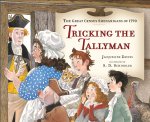
Tricking the Tallyman
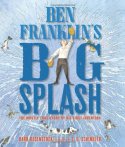
Ben Franklin’s Big Splash: The Mostly True Story of His First Invention
.
.

Filed under:
5stars,
Children's Books,
Debut Author,
Favorites,
Library Donated Books,
Picture Book Tagged:
Benedictine monks,
children's book reviews,
Eerdmans Books for Young Readers,
Katy Beebe,
La Grande Chartreuse,
Middle Ages,
parchment,
picture book,
S. D. Schindler,
Wm. B. Eerdmans Publishing Company 







 Author: Laura Leuck
Author: Laura Leuck
Illustrator: S. D. Schindler (on JOMB)
Published: 2003 Walker Books (on JOMB)
ISBN: 0802777295
Chapters.ca Amazon.com
A ghastly cast of grinning graveyard neighbours pool revolting resources to concoct (and consume) an oozing, gurgling, gruesome stew in this superbly illustrated Hallowe’en counting rhyme.
Other books mentioned:
Pop over to Big A, Little A for today’s full menu of poetry offerings. Poetry Fridays are brought to us by Kelly Herold of Big A, Little A.
HOTLINE VOICES: Thanks to Todd Melby of 2 Below Zero for telling us about The Witches (by Roald Dahl and Quentin Blake).
We’d love to hear your thoughts on a favourite children’s book. Leave us a voice message on our JOMB listener hotline, +1-206-350-6487.
 But a twelfth century Brother Hugo could and did. Or at least he does in the delightful and engaging Brother Hugo and the Bear by Katy Beebe, illustrated by S. D. Schindler .
But a twelfth century Brother Hugo could and did. Or at least he does in the delightful and engaging Brother Hugo and the Bear by Katy Beebe, illustrated by S. D. Schindler .













 Author: Laura Leuck
Author: Laura Leuck
I think my son has used the excuse “The dog ate my homework” – and we don’t even have a dog.
The illuminated manucscripts came out great! (Love the washing drying on the radiator – every picture I take in my house in the winter has this as a backdrop!)
ha! I hadn’t even noticed the washing in the photo Claire! I’m sure there must be a book somewhere which has compiled crazy homework excuses…
What a beautiful book, your letters remind me of when my dad went to Lindisfarne and sent me several postcards, I was very taken with the style. And our very dear friends in Belgium met when they worked together on the The Secret of Kells, they have some of the cels up in their house.